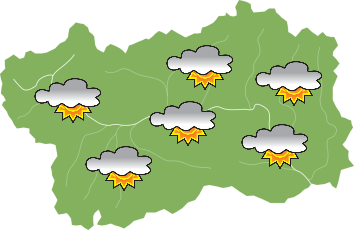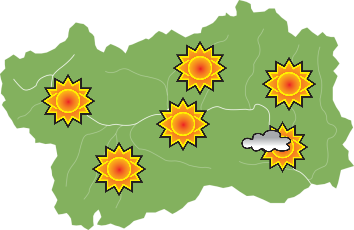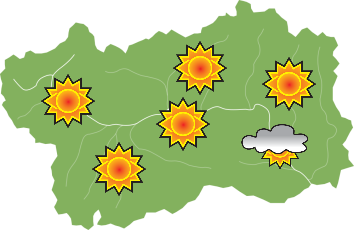Search here for information about all museums in the Aosta Valley: timetables, prices and conditions of visit.
Browse
Weather forecast
Meteo
Saturday 10 January


Sunday 11 January


Monday 12 January


Book your Holiday
Coumba Frèida Carnival museum
Museums - AlleinThe exhibition, situated in a fortified house dating back to the 16th century, proposes a journey through the ancient Carnival who animates the villages of the Gran San Bernardo valley.
Its realisation has been possible thanks to:
• photographs of the exhibition “Quand l’ours se réveille… - Le Carnaval en Vallée d’Aoste de 1900 à 1970”, property of BREL;
• material coming from the AVAS archives
• works realized inside the “Project Carnaval”, by the schools belonging to the Grand Combin scholastic institution
• european project “Grand-Saint-Bernard 360°”
• material borrowed or donated by private citizens
Ethnographic museum "Un tempo, la veillà nella stalla"
Museums - Antey-Saint-AndréThe museum gives the possibility to discover the way of life in ancient times, when human being used to share the same room with animals, in order to warm naturally the place in which he lived.
In the kitchen we see a mother with her daughter doing housework, while the father and his son take care of calf, sheep, goat, hen and rabbit in the cowshed.
It is also possible to see the tools used in the past for agriculture works, now replaced more and more by modern and technological objects.
MegaMuseo - Megalithic area of Aosta
Archeology - AostaOne of the most interesting prehistoric archaeological sites in Europe but also a place where history has continued to leave evidence even in subsequent centuries. Come to Aosta and take advantage of the museum's initiatives and guided tours and discover all the technological innovations of the recent museum setup.
The archaeological site
The area, brought to light in 1969, measures approximately one hectare, and is one of the most interesting archaeological sites in Europe, offering a fascinating overview of significant moments stretching across almost 5000 years of history, from the late Stone Age up to the present.
The term megalithic area has been used as a summary description of the finds in Aosta, which has currently no equal, and can only be compared - albeit partially - with the site at Sion, Petit-Chasseur, in Switzerland.
“Megalithic area” refers to a portion of land of a certain, clearly defined size, featuring a variety of different megalithic monuments.
This site is more than just a simple line-up of menhirs or standing stones featuring human figures, or a burial ground, or a series of individual dolmen tombs: these finds demonstrate the existence of a sacred area destined from its origins to hosting recurring activities linked to worship and burial.
Five structural phases have been identified, from the Recent Neolithic (end of the 5th millennium B.C.) through the Copper Age (4th - 3rd millennium B.C.) to the Bronze Age (2nd millennium B.C.).
Initially conceived as an open-air sanctuary destined for the cult of the living, it was not until the latter centuries of the 3rd millennium that it became an important burial ground, with monumental tombs of a variety of megalithic types.
In chronological order, visitors can observe: traces of a propitiatory furrow ritually sown (end of the 5th millennium B.C.), followed by the creation of a line of wells, at the bottom of which are ritual offerings such a millstones, along with the remains of fruit and cereals.
From a later point in time (beginning of the 3rd millennium B.C.) was a line of at least 24 wooden totem poles facing from North East to South West, later replaced by 46 huge anthropomorphic steles, the first authentic manifestation of in this area of megalithism, magnificent masterworks of prehistoric statue construction.
The area took on a clear burial function with the construction of the first megalithic tombs, which were probably occupied by distinguished families from the community and were built entirely above ground. A particularly significant example is the so-called “Tomb 2”, erected on a distinctive triangular platform of stones, used for almost a thousand years as a collective tomb and containing the remains of 39 individuals.
The museum
Visiting the museum implies a trip back from the present day into the prehistorical age: along a route dotted with images referring to human history, the walkways that set out from the entrance to the museum take visitors down to the level of the actual archaeological site (about 6 metres below road level).
The view here is striking as visitors explore the dimensions of time, the tones of the light colour the environment that envelops the archaeological finds: the dolmen, the standing stones brought down, the platform, the traces of the grooves ploughed…
The visitor route constantly looks out onto the archaeological site, in a sort of on-going dialogue between the indoors (the museum) and the outdoors (the site). Explanations, further details and interpretations can be found on the learning and multimedia supports.
Not to be missed:
- the suggestive ramp of time enriched by three-dimensional elements
- the astonishing Immersive room
- the large hall of steles where you can admire 46 anthropomorphic stelae found on the site
- The section dedicated to Protohistory which illustrates the great changes that occurred in the area at the beginning of the 2nd millennium BC, when the agricultural function took over the funerary one: numerous human footprints can be observed imprinted in the plowed land found on the occasion of the most recent archaeological excavations. Furthermore, in this space you can appreciate the large funerary mound from the Iron Age (1st millennium BC) with its original walking surface
- on the upper floor the protagonist is the Roman era divided into two sections: one dedicated to daily life in a rustic environment, and the other to the necropolises excavated over the years along the road, below the parish church and the nursery school; here there are 20 tombs characterized by very rich grave goods, as well as very different funerary practices and rituals in terms of chronology and typology
- the medieval section concludes the visit itinerary by presenting evidence relating to the small Romanesque church of Saint Martin.
There is also an area dedicated to temporary exhibitions and a conference room.
Cathedral Treasure Museum
Museums - AostaLocated in the cathedral ambulatory, the museum provides a significant overview of Val d’Aosta art between the 13th-18th centuries, combining pieces from the Cathedral’s rich treasure with works of art originating from different parishes in the Valley.
The most precious examples include a chimney from the Roman era with precious stones and pearls set in a gold frame from the 13th century, used as a cope buckle; the unique pieces include the diptych of Honorius, testimony of late Roman art.
Among the important Gothic sculptures are a wooden paliotto sculpted in the 13th-14th century.
The rich gold collection contains French items of Limousin art, precious silver relic busts with inscriptions and set with crystals and precious stones. Outstanding pieces include the large relic chest of Saint Gratus, which was created by William of Locana and, after his death, was entrusted to the Flemish sculptor Jean de Malines.
The museum holds a collection of marble sepulchral sculptures, 15th-century productions of the Val d’Aosta artist Stefano Mossettaz.
Manzetti Museum
Museums - AostaInnocenzo Manzetti (Aosta, 1826 – 1877) was scientist and inventor. Creative but pragmatic mind, he was known inside the scientific community for his inventions: an automaton playing flute, a steam car, a hydraulic pump, an exceptionally precise sculpting machine, a special hydraulic cement and many other objects. Some sources describe him as a forerunner of the telephone’s invention, which he studied and improved between 1844 and 1864, eventhough he never patented it.
The permanent exhibition Innocenzo Manzetti: the inventor and his Automaton is located inside the Aosta Saint-Bénin Center, in a special room within the antique church sacristy.
A modern showcase contains the original Automaton and the harmonium, designed, constructed and adapted by Manzetti himself.
On the walls, six interactive screens allow to access at all the information available about Manzetti and his inventions.
Particular attention is given to themes such as the inventor’s biography, the depiction of the historical context in which he lived, his scientific interests and an accurate description of all his creations. Moreover, a 3D virtual animation simulates the functioning of the Automaton’s mechanisms in relation to the movement of the harmonium keys.
Finally, two small screens are installed to show simplified information, specifically conceived for children.
MAR - Regional Archaeological Museum
Museums - AostaThe MAR-Regional Archaeological Museum, until the new rearrangement, becomes META/MAR Cantiere Museale Partecipato
Site included in the Aosta archeologica cumulative ticket
The Regional Archaeological Museum has a thematic and chronological itinerary.
In the first hall, dedicated to the abbot Justin Boson, first director of the Regio Museo in 1929, are exhibited tiles and north-african oil lamps coming from regional collections.
On the trail of the commercial and cultural axes of the areas of Mesopotamia and Anatolia, as well as following the transmission of megalithic monuments’ models, the exhibition includes some anthropomorphic steles discovered at the extraordinary archaeological site of Saint-Martin-de-Corléans, while in the show-cases are exposed artifacts found in Aosta Valley and dating back to the period going from the Mesolithic to the Salassi era.
Further on, the visit enters the wide space dedicated to Romanization, starting with the model of Augusta Praetoria and the milestone of Constantine, in the past positioned along the Road to Gauls. The two following rooms are reserved to the burial rituals and present some grave goods, together with a reconstruction of a funeral bed found in an incineration tomb in the necropolis of Saint Roch, at the eastern entrance of the roman city. The areas consecrated to the funeral epigraphs and local cults show various pieces, including the famous bronze balteus (belt) with battle scenes between Barbarian and Roman and the silver bust of Jupiter Dolichenus found at the Little St. Bernard Pass with other ritual objects. Public building works are depicted in a collection of prints with the main Aostan monuments, together with fragments of sculptures and frescoes, while everyday life is represented in table and cooking ornaments disposed in the reconstruction of a thermopolium (public place used to serve food and drinks). The roman section ends with the exhibition of personal ornaments and objects related to luxury and well-being.
The Christian-Medieval epoch is represented by the precious 8th-century pulpit found during excavations at Aosta Cathedral and some grave goods from the 4th to the 14th century, including gold decorated glasses and the knight’s sword coming from the Collegiate Church of Sant’Orso.
In the basement area of the Regional Archaeological Museum are conserved the remains of the south-eastern edge of the eastern tower of the Porta Principalis Sinistra, one of the four city gates of Augusta Praetoria, with the Roman levels and the only section of embankment, with the relative counterscarp, still resting on a part of the Roman walls.
The museum finally houses the prestigious “Pautasso” numismatic collection, with coins from the Greek era to the Savoy period. To notice the collection of Celtic, Gallic and Padanian coins.
The hall of the Carugo Collection exhibits findings of Etruscan civilization, of Ancient Egypt and Mesopotamia.
Parish museum
Museums - ArnadThe parish museum preserves some interesting sacred objects, including a crucifix from the second half of the thirteenth century and two German bas-reliefs representing St. Rocco and St. Sebastian, attributed to the school of the sculptor Michael Parth (second half of the sixteenth century).
Maison de Mosse
Museums - AviseThis fortified house was built by the D’Avise family close to the Gaul roman road in the village of Runaz. At the end of the 15th century Jean le Jeune, lord of Runaz, transformed the building into a residence, whose beautiful widows in late-gothic style, dating back to the 16th century are still admirable. Also worthy to see is the main entrance door.
The structure, which hosts ethnographic and historical exhibitions, is also the seat of the Association Valdôtaine des Archives Sonores who is responsible of its management.
Parish museum
Museums - AviseThe museum, situated in the first side chapel on the right of the Saint Brice parish church, hosts different sacred works coming both from the same church and from the chapels of the villages Vedun, Charbonnière, Cerellaz and Runaz.
The statues and sacred objects exposed cover a period of time going from 15th to 19th century: moreover, it is possible to admire an important series of goldsmith’s crafts and a textile manufacture probably created in an italian workshop active at half of the 18th century.
Chestnut Ecomuseum
Museums - BardIn the ancient times the chestnut was a base component of the peasant diet, especially in mid mountain villages.
In the village of Albard di Bard, to demonstrate the processing of this product a ‘‘grehe’‘ has been set up, a characteristic small two-storey rural building used to dry chestnuts.
In the same building, in the area once used as a deposit, you can see the original equipment for processing chestnuts along with illustrative panels: the hammer to open them, the pincers to extract them from their cases, the sacks of rough hemp to be beaten on a wooden block to remove the shells, which were then eliminated by shaking it with a winnow (’‘lo van’‘, in dialect).
The museum is only open for special events.




-9424%20(1).jpg?v=638267413400000000)

